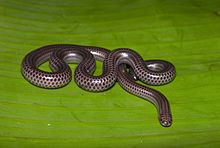
The Leptotyphlopidae are a family of snakes found in North America, South America, Africa and Asia. All are fossorial and adapted to burrowing, feeding on ants and termites. Two subfamilies are recognized.

Erythrolamprus is a genus of colubrid snakes, commonly known as false coral snakes, native to Central America, the Caribbean, and the northern part of South America. They appear to be coral snake mimics.

Epictia is a genus of snakes in the family Leptotyphlopidae. The genus is native to South America, Central America, and Mexico.

Siagonodon is a genus of snakes in the family Leptotyphlopidae. The genus contains five species, all of which were previously placed in the genus Leptotyphlops.
The Venezuela blind snake is a species of snake in the family Leptotyphlopidae.
Bailey's blind snake is a species of snake in the family Leptotyphlopidae. The species is endemic to Ecuador.
Tricheilostoma broadleyi is a species of snake in the family Leptotyphlopidae. The species is endemic to Ivory Coast.
Joshua's blind snake is a species of snake in the family Leptotyphlopidae. The species is endemic to Colombia.

Amaral's blind snake is a species of snake in the family Leptotyphlopidae. The species is native to South America.
The Mato Grosso blind snake is a species of snake in the family Leptotyphlopidae. The species is native to northeastern South America.
The dainty blind snake is a species of snake in the family Leptotyphlopidae.
Dugand's blind snake is a species of snake in the family Leptotyphlopidae. The species is endemic to South America.
The Santander blind snake is a species of snake in the family Leptotyphlopidae. The species is endemic to Colombia.
Sundevall's worm snake is a species of snake in the family Leptotyphlopidae. The species is endemic to Central Africa and West Africa.
The Guayaquila blind snake is a species of snakes in the family Leptotyphlopidae.

The big-scaled blind snake is a species of snake in the family Leptotyphlopidae. The species is endemic to southern Central America and northern South America.
The Espírito Santo blind snake is a species of snake in the family Leptotyphlopidae. The species is endemic to Brazil.

Atractus is a genus of colubrid ground snakes in the subfamily Dipsadinae. The genus includes more than 140 distinct species.

Epictinae are a subfamily of snakes found in the New World and equatorial Africa. Members of this subfamily tend to have short, thick tails, and the fewest subcaudal scales. It comprises two tribes, three subtribes, ten genera, and 86 species.

Myriopholis is a genus of snakes in the family Leptotyphlopidae. Most of the species were previously placed in the genus Leptotyphlops.








